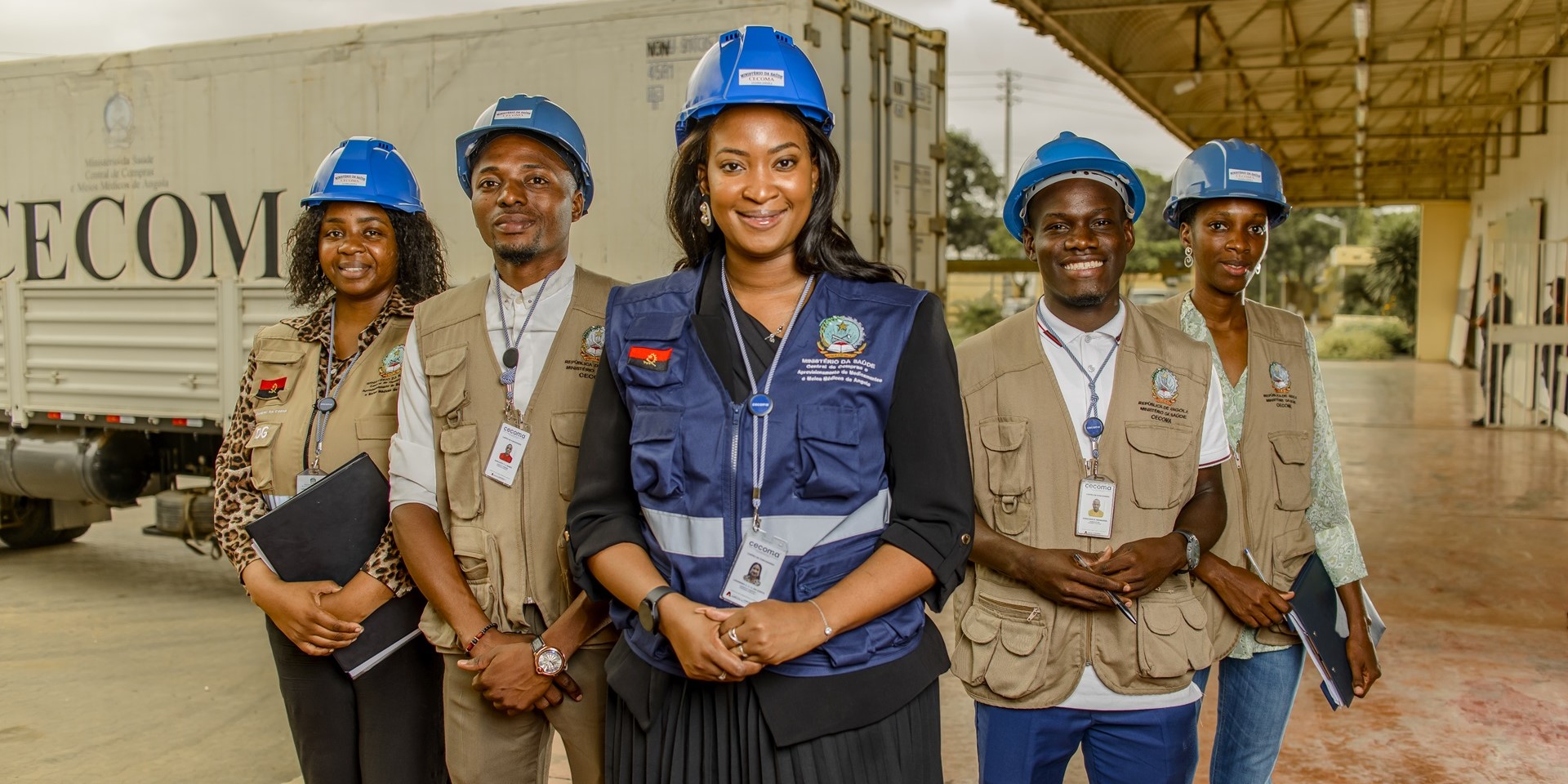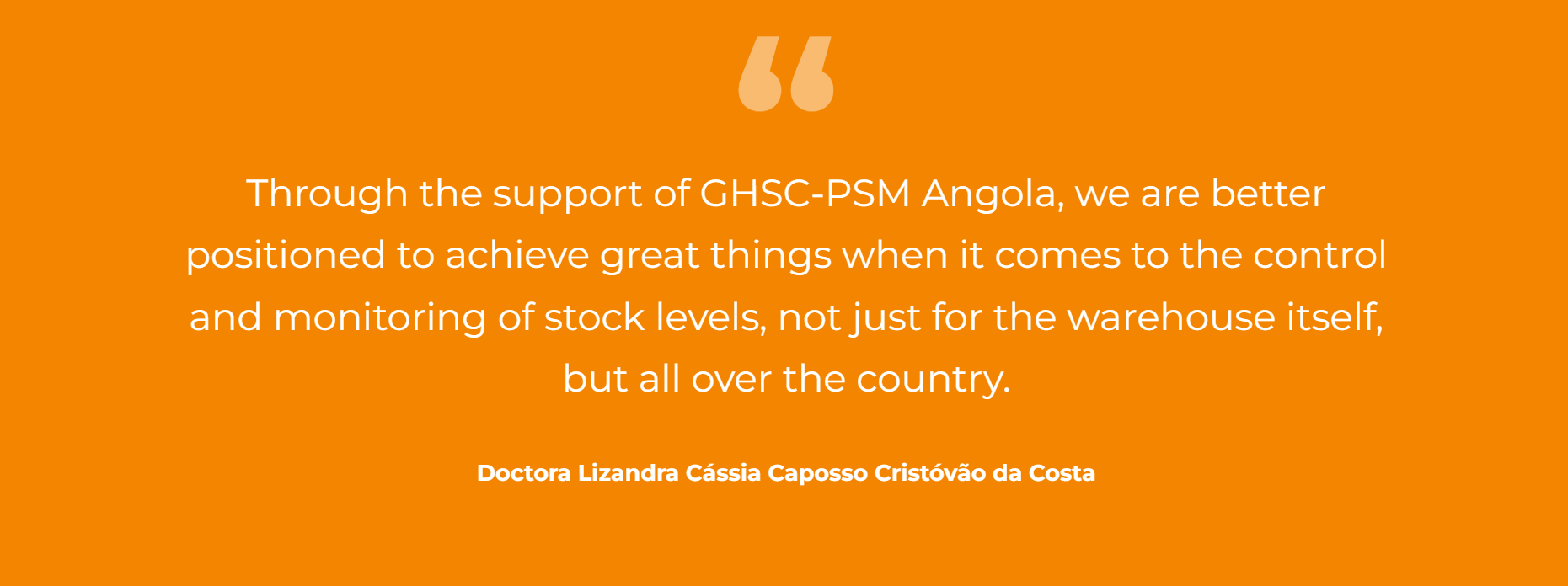Doctora Lizandra Cássia Caposso Cristóvão da Costa unpacks the crucial role an effective supply chain has to play in Angola’s healthcare system.

*This blog originally appeared on the Chemonics website and can be found at https://chemonics.com/blog/the-beating-heart-of-angolas-healthcare-system/
Without an effective supply chain, it is nearly impossible to ensure that people can access the healthcare they need. In Angola, the USAID Global Health Supply Chain Program-Procurement and Supply Management (GHSC-PSM) project provides technical assistance to the government, focused primarily on supporting the Ministry of Health (MOH) and the Central Procurement Agency for Medicines and Medical Supplies Central Medical Store (CECOMA) in public administration, financial management, and supports health system strengthening. CECOMA, which operates under the MOH, is responsible for the national supply chain and procurement of medicines and medical equipment and conducts the distribution and logistics to support warehouses around the country.
We spoke to Doctora Lizandra Cássia Caposso Cristóvão da Costa, general director of CECOMA and passionate health supply chain expert, to better understand the challenges Angola has experienced in the past, and how CECOMA’s work with GHSC-PSM has contributed to solving those challenges. In her current role, Lizandra oversees the daily operations and plans to ensure CECOMA’s overall objectives and goals are accomplished. She also oversees the national health stock levels, storage, and distribution of medicine and medical equipment that the Government and donors procure across all provinces of the country.
What is your biggest motivation for working in the health sector, particularly in health supply chain, and how long have you done so?
I have this phrase that I’ve been saying since I was in college, and it means a lot to me: “I don’t think I chose the health sector, I think the health sector chose me”, because I have the biggest love for what I do. I can completely say that I’m one of those people that actually works doing what they love.
My motivation is to give the same standards and best practices of healthcare that I was exposed to throughout my journey in college to the Angolan population. The same exact health care that I saw and have experienced in other countries that I visited and lived in. Implementing it here is my greatest motivation.
The supply chain is the way to go, because everything starts with the supply chain. We can have the best doctors, we can have the best infrastructure, we can have the best equipment; but if the supply chain is faulty, our efforts can go to waste. Through the supply chain, we are able to guarantee that the population has access to the required medicine and medical treatment to build a very strong health sector.
I’ve been working at CECOMA for three and a half years. I was the deputy general director for two years, and now I’ve been the general director for 18 months. But I’ve been working in supply chain way before that, just not as directly as I’m doing right now. While working at the MOH, I was located in the hospital area that always collaborated a lot with CECOMA.
So, supply chain is really in my heart.
How does CECOMA work with the GHSC-PSM project?
GHSC-PSM Angola provides technical support for inventory management and general in-country logistics, and collaborates with CECOMA on distribution planning and monitoring, among other things. They took our vision and mission and honed it for better collaboration with other key stakeholders and have been a great force in helping CECOMA achieve its goals.
We have become more than just colleagues – we have become family as we’ve worked together to overcome many obstacles, including reducing reliance on ad hoc, manual processes and introducing standardized processes instead, building HR capacity, and updating an outdated national supply chain strategy. They’ve been there through everything that we thought we couldn’t make – they were making sure that our sparkle, our dreams, everything that we really wanted to achieve, and the supply chain of the country, was possible. It makes me emotional reflecting on everything that we’ve done together.
Looking back, what challenges was Angola facing, and what do you think is the most significant change that has occurred in the country’s health system since USAID began supporting CECOMA through GHSC-PSM?
Before GHSC-PSM’s support, we weren’t able to track anything and several aspects of the work were ad hoc, which means that we had a lot of loss during the process of distribution of medicines. It was very hard to have data and to make well informed decisions. Through their support and through their constant technical assistance, we’ve been able to close a lot of those gaps. We have also been able to work more efficiently and with a mission to understand what we’re missing and how we can close that gap. The project was able to support in every way related to supply chain, varying from training, strategic planning, workshops and technical assistance.

Angola’s Integrated Supply Chain Management System, SIGECA, has been the epitome of this support, as it’s a project that we’ve been working very hard and waiting on for over seven years. This digital strategy has been the greatest and most significant change that occurred in the Angola health system. Through the support of GHSC-PSM Angola, we are better positioned to achieve great things when it comes to the control and monitoring of stock levels, not just for the warehouse itself, but all over the country. We’ve been able to obtain more accurate data from hospitals for the decision-making process. So, the most significant support through GHSC-PSM Angola is SIGECA. SIGECA is our baby. We started it together, and it’s great to see that it was finally born and it’s working. We are now poised to track medicines all over the country. We are now able to understand how the demographical changes affect the supply chain, especially for the health system. We’re better able to make more accurate decisions on the distribution, and that is a huge support.
Banner image caption: Doctora Lizandra Cássia Caposso Cristóvão da Costa and her team at Angola’s central medical store, CECOMA, work closely with the USAID GHSC-PSM project to strengthen that country’s health supply chain.
Posts on the blog represent the views of the authors and do not necessarily represent the views of Chemonics.